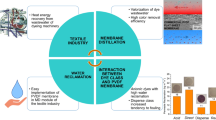Abstract
Direct contact membrane distillation technology was considered as a promising and efficient technology for the treatment of textile wastewater. In this study, hydrophobic polytetrafluoroethylene and polyvinylidene fluoride membranes for the treatment of selected model compounds of textile wastewater (e.g., phenol, aniline, and sulfanilic acid) were explored comparatively in a bench-scale direct contact membrane distillation technology test unit. The effect of various operational parameters including temperature, flow rate, and concentration on the rejection performance was investigated systematically. The results indicated that an increased feed temperature and a faster cross flow velocity contributed positively to the direct contact membrane distillation performance. Limited rejection for phenol and aniline was witnessed, which can be due to their relatively lower boiling point. A > 99% of sulfanilic acid rejection was obtained under the same conditions. Furthermore, the polytetrafluoroethylene membrane always presented enhanced performance compared with the polyvinylidene fluoride samples. In brief, the direct contact membrane distillation process could be potentially used as a promising technique for the treatment of textile wastewater.






Similar content being viewed by others
References
Abd Jalil SN, Wang DK, Yacou C, Motuzas J, Smart S, da Costa JCD (2017) Vacuum-assisted tailoring of pore structures of phenolic resin derived carbon membranes. J Membr Sci 525:240–248. https://doi.org/10.1016/j.memsci.2016.11.002
An AK, Guo J, Jeong S, Lee EJ, Tabatabai SA, Leiknes T (2016) High flux and antifouling properties of negatively charged membrane for dyeing wastewater treatment by membrane distillation. Water Res 103:362–371
Armand SB, Fouladitajar A, Ashtiani FZ, Karimi M (2017) The effect of polymer concentration on electrospun PVDF membranes for desalination by direct contact membrane distillation. European Water 58:21–26
Cai J, Guo F (2017) Study of mass transfer coefficient in membrane desalination. Desalination 407:46–51
Chen J, Wang Q, Hua Z, Du G (2007) Research and application of biotechnology in textile industries in China. Enzyme Microb Tech 40:1651–1655
Chhabra M, Mishra S, Sreekrishnan TR (2015) Combination of chemical and enzymatic treatment for efficient decolorization/degradation of textile effluent: high operational stability of the continuous process. Biochem Eng J 93:17–24
Dasgupta J, Sikder J, Chakraborty S, Curcio S, Drioli E (2015) Remediation of textile effluents by membrane based treatment techniques: a state of the art review. J Environ Manag 147:55
Drioli E, Ali A, Macedonio F (2015) Membrane distillation: recent developments and perspectives. Desalination 356:56–84
Eykens L, Sitter KD, Dotremont C, Pinoy L, Bruggen BVD (2017) Membrane synthesis for membrane distillation: a review. Sep Purif Technol 182:36–51. https://doi.org/10.1016/j.seppur.2017.03.035
Figoli A, Ursino C, Galiano F, Nicolò ED, Carnevale MC, Criscuoli A (2016) Innovative hydrophobic coating of perfluoropolyether (PFPE) on commercial hydrophilic membranes for DCMD application. J Membr Sci 522:192–201
Khalifa A, Ahmad H, Antar M, Laoui T, Khayet M (2017) Experimental and theoretical investigations on water desalination using direct contact membrane distillation. Desalination 404:22–34
Kim S, Dong WL, Cho J (2016) Application of direct contact membrane distillation process to treat anaerobic digestate. J Membr Sci 511:20–28
Liang B, Zhan W, Qi GG, Lin SS, Nan Q, Liu YX, Cao B, Pan K (2015) High performance graphene oxide/polyacrylonitrile composite pervaporation membranes for desalination applications. J Mater Chem A 3:5140–5147
Lou M, Ding L, Zhao F, Li F, Ma C, Tian Q, Liu Y (2017) Performance of direct contact membrane distillation for simulated dyeing wastewater treatment. European Water 58:223–228
Lu KJ, Zuo J, Chung TS (2016) Tri-bore PVDF hollow fibers with a super-hydrophobic coating for membrane distillation. J Membr Sci 514:165–175
Marcucci M, Ciardelli G, Matteucci A, Ranieri L, Russo M (2002) Experimental campaigns on textile wastewater for reuse by means of different membrane processes. Desalination 149:137–143
Mohamed ES, Boutikos P, Mathioulakis E, Belessiotis V (2017) Experimental evaluation of the performance and energy efficiency of a vacuum multi-effect membrane distillation system. Desalination 408:70–80
Mokhtar NM, Lau WJ, Ismail AF, Kartohardjono S, Lai SO, Teoh HC (2016) The potential of direct contact membrane distillation for industrial textile wastewater treatment using PVDF-Cloisite 15A nanocomposite membrane. Chem Eng Res Des 111:284–293
Ozturk E, Koseoglu H, Karaboyaci M, Yigit NO, Yetis U, Kitis M (2016) Sustainable textile production: cleaner production assessment/eco-efficiency analysis study in a textile mill. J Clean Prod 138:248–263
Saha S, Das C (2017) Purification of humic acids contained simulated wastewater using membrane ultrafiltration. European Water 58:33–40
Segato L, Mattioli W, Capello N, Migliorini M (2017) Environmental crimes in the water sector. European Water 60:373–379
Sundar LS, Sharma KV, Singh MK, Sousa ACM (2017) Hybrid nanofluids preparation, thermal properties, heat transfer and friction factor a review. Renew Sust Energ Rev 68:185–198
Tsiourtis NX (2017) Desalination and alternative water resources. European Water 58:103–109
Wang P, Chung TS (2015) Recent advances in membrane distillation processes: Membrane development, configuration design and application exploring. J Membr Sci 474:39–56
Acknowledgments
This work is supported by the National Key Research and Development Program of China (Grant No. 2016YFC0400501) and the Start-up Grant of Donghua University (Grant No. 113-07-005710), the National Natural Science Foundation of China (Grant No. 51478099). A previous shorter version of the paper has been presented in the 10th World Congress of EWRA “Panta Rei” Athens, Greece, 5-9 July 2017.
Author information
Authors and Affiliations
Corresponding authors
Additional information
Highlights
1. High feed temperature and flow rate had a positive correlation to the permeate flux.
2. PTFE membrane obtained better performance than the PVDF membrane.
3. High hydrophobicity prevents the feed solution steam into membrane pores.
Electronic supplementary material
ESM 1
(DOCX 18 kb)
Rights and permissions
About this article
Cite this article
Ji, M., Xia, Q., Chen, H. et al. Treatment of Typical Organic Pollutants in Textile Wastewater by Direct Contact Membrane Distillation. Environ. Process. 5 (Suppl 1), 77–85 (2018). https://doi.org/10.1007/s40710-018-0292-9
Received:
Accepted:
Published:
Issue Date:
DOI: https://doi.org/10.1007/s40710-018-0292-9




